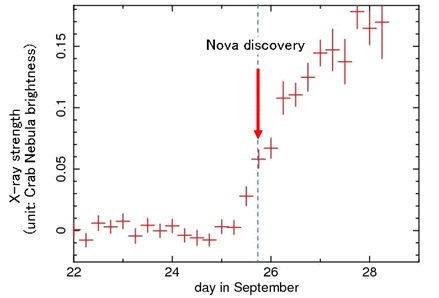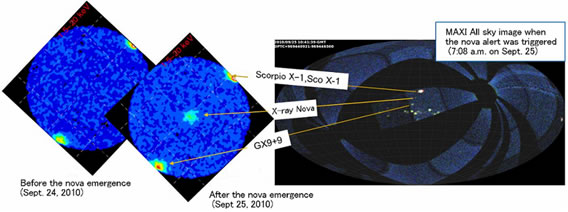Discovery of an X-ray Nova
by the Monitor of All-sky X-ray Image (MAXI)
Japan Aerospace Exploration Agency (JAXA)
Institute of Physical and Chemical Research (RIKEN)
The Monitor of All-sky X-ray Image (MAXI) mission team discovered an X-ray nova by MAXI's X-ray cameras, which are working on the Exposed Facility of the Japanese Experiment Module "KIBO" of the International Space Station. The team immediately reported their discovery to the world.
This X-ray nova emerged in the constellation of Ophiuchus, and the MAXI nova alert system detected its emergence at around 7:00 p.m. on September 25, 2010 (Japan Standard Time, all the following dates and times are JST.) The discovery was immediately notified to all researchers registered on the MAXI mailing list, and with their detailed analysis the MAXI team confirmed that it is an uncatalogued X-ray source. The nova was named "MAXI J1659-152," and the discovery was reported to the world through the Astronomer's Telegram, ATel, at around 1:00 a.m. on September 26.

Change of X-ray Strength over time when the nova was discovered.
The X-ray strength drastically increased on Sept. 25. At around 7:00 p.m. on Sept. 25,
the MAXI nova alert system captured this increase.
Following the discovery, many astronomical observatories around the world have started observing this nova in X-ray, gamma-ray, visible, infrared, and radio wavelengths. As of 0:00 a.m. on Sept. 29, seventeen reports have been issued on this matter. Astronomers across the world are paying attention to this nova as it is likely to be a binary system with a black hole. The Japanese X-ray Astronomy Satellite "Suzaku" is also conducting detailed observations.
This discovery was led by Prof. Hitoshi Nego, a member of the MAXI team.
|
|
